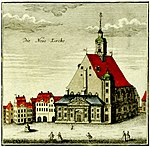Leipzig Zoological Garden

Leipzig Zoological Garden, or Leipzig Zoo is a zoo in Leipzig city, Germany. It was first opened on June 9, 1878. It was taken over by the city of Leipzig in 1920 after World War I and now covers about 27 hectares (67 acres) and contains approximately 850 species. By 2020 the zoo featured six different theme worlds, aiming at providing habitats appropriate for the species on display. Leipzig zoo is internationally noted for its large building projects such as Pongoland (housing gorillas, chimpanzees, bonobo and orangutans) and Gondwanaland (world's second largest indoor rainforest hall at 1.65 ha or 4.1 acres). It has bred more than 2,000 lions, 250 rare Siberian tigers, and other carnivores like bears. Leipzig Zoological Garden has been called the "Zoo of the future". It is ranked as the best zoo in Germany and also the second-best in Europe (after Vienna).
Excerpt from the Wikipedia article Leipzig Zoological Garden (License: CC BY-SA 3.0, Authors, Images).Leipzig Zoological Garden
Pfaffendorfer Straße, Leipzig Centre North (Mitte)
Geographical coordinates (GPS) Address Phone number Website External links Nearby Places Show on map
Geographical coordinates (GPS)
| Latitude | Longitude |
|---|---|
| N 51.349 ° | E 12.369 ° |
Address
Zoo Leipzig
Pfaffendorfer Straße 29
04105 Leipzig, Centre North (Mitte)
Saxony, Germany
Open on Google Maps









